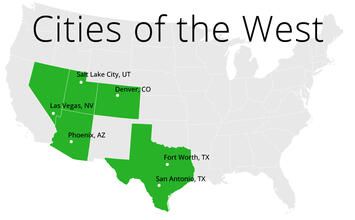
America’s western cities are booming. The major metropolitan areas of the West—defined as the vast region west of the 98th parallel and east of the Cascade and California Coast Ranges—have far outperformed most other U.S. metros over the last several decades in attracting people and businesses and creating opportunity for their residents.
The continuing growth of America’s western urban civilization is an undertold success story. A unique mix of historical forces has shaped the cities of the West, despite the many differences among them. One central fact is that the West’s cities were late to develop relative to other U.S. cities. Another is that when they did, a distinctively modern form of American capitalism fueled their growth.
But a third force also made a decisive difference in the success of America’s western cities: aggressive federal policies that promoted the region’s economic growth. The policy program that helped build the West reflects a tradition closely associated with the thinking of Alexander Hamilton, Henry Clay, and Abraham Lincoln, but which only saw its full flowering in the West in the decades following the Civil War and continuing today.
There are 63 metropolitan areas between the 98th parallel and the Pacific Coast Ranges, based on U.S. Census Bureau definitions. These include seven with more than a million residents: Phoenix, Denver, San Antonio, Las Vegas, Salt Lake City, Tucson, and Fresno. It also makes sense to include the Fort Worth side of the Dallas-Fort Worth metro, despite its location a fraction of a degree east of the 98th parallel, in view of Fort Worth’s heavy emphasis on its western heritage and its motto, “Where the West Begins.”
Total population in these 64 metros, including the Fort Worth-Arlington metro division but not the eastern side of the Dallas-Fort Worth area, grew 14 percent from 2010 to 2021, compared with 9 percent for America’s 385 metro areas as a whole. But this growth reflects a wide range of experiences, with tepid growth in the struggling metros of California’s Central Valley and the Lower Rio Grande Valley and rapid expansion in the largest urban areas.
In the six largest areas—Phoenix, Denver, San Antonio, Fort Worth, Las Vegas, and Salt Lake City—plus smaller nearby metros within commuting distance of these places such as Tucson and Provo, Utah, population grew 19 percent between 2010 and 2021. These six areas are home to 24 million of the 37 million people living in the West’s metros, or 7 percent of America’s population.
Read the rest of this piece at The American System.
J. H. Cullum Clark is director of the George W. Bush Institute–Southern Methodist University Economic Growth Initiative and an adjunct profes-sor of economics at Southern Methodist University in Dallas, Texas. He is coauthor of The Texas Triangle: An Emerging Power in the Global Economy (Texas A&M University Press, 2021).












